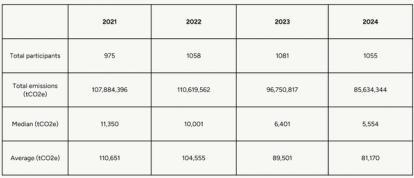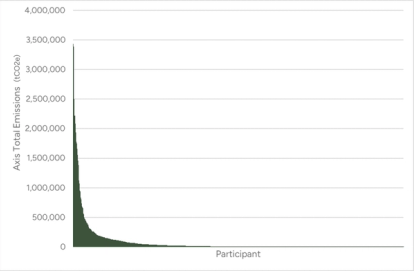
Carbon & Energy Newsletter (UK) - June 2025
- Post Date
- 04 July 2025
- Read Time
- 9 minutes

It’s time for summer and the holidays to begin, but before that we’d like to welcome you to the June 2025 edition of your Carbon and Energy Newsletter.
In this month’s edition, we have a wide range of updates starting with a review on the recent release of the UK government’s 2025 GHG Conversion Factors for Company Reporting. We then have notices on the Industrial Energy Transformation Fund, UK Emissions Trading Scheme (UK ETS) and Science Based Targets initiative (SBTi). Finally, we will conclude with the opening of CDP’s disclosure window and upcoming Energy Savings Opportunity Scheme (ESOS) requirements.
Insight of the month
Recent reports by climate scientists have warned that there are only two years of the world’s carbon budget left to meet a 1.5°C target. The carbon budget is how much CO2 can still be emitted before hitting a point where extreme climate conditions will impact communities around the world. Current projections by climate scientists forecast that the world is on track for 2.7°C of warming and at the current pace 1.5°C will be exhausted by 2027. To achieve a 66% chance of keeping below the 1.5°C target, emissions from 2025 onwards must be limited to 80 billion tonnes of CO2. This means more needs to be done to improve global decarbonisation.
UK government’s GHG Conversion Factors for Company Reporting
The latest UK government conversion factors have been released for 2025 reporting. [1]
There have been several significant changes to review, but the first that always piques our interest is the UK electricity emission factor. For 2025, this has reduced by 15% due to a reduction in natural gas power stations and increase in net imports of electricity. It’s a worthwhile reminder that a two-year data lag is always in place for the source information, therefore numbers relate to the 2023 period. Great news for those using location-based GHG accounting but raises questions on whether we are just moving our emissions for electricity generation overseas!
The knock-on effect of a reduced UK electricity emission intensity is that there is also a noticeable reduction in UK electric vehicle (EV) emission factors (ranging from -13% to -22%). Vehicles in general have shown the most significant conversion factor changes from the previous year. Vans and HGV factors using a tonne.km factor saw increases of around 22% and 10% respectively, noted as a result of a decrease in the quantity of average goods loaded. On the other hand, transport by air has shown the opposite impact, with the passenger.km for all factors demonstrating a reduction (between -16% to -42%). This is following the Covid-19 rebound and refreshed calculations whereby more air travel is taking place than previous calculations, which are based on 2021 data. Other conversion factor changes to note are water supply with a 25% increase and waste disposal factors with a -27% decrease across construction and electrical waste (both due to input methodology changes).
To access the document highlighting all major changes to the conversion factors, please see [2] in references section.
Industrial Energy Transformation Fund
The Industrial Energy Transformation Fund (IETF) has come to an end.
Following a spending review this month, it has been decided that there will be no further extension of the IETF and no successor funding to UK industry. The government has said that it is still committed to delivering the £163 million of funding for current projects through to completion (from Phases 1, 2, and the first Phase 3 competition window), but nothing will follow. Instead, it seems that funding will be placed into “supporting electrification” and “substantial funding in the development of CCUS and hydrogen infrastructure”.
UK Emission Trading Scheme (UK ETS)
As always, there are plenty of updates in the world of UK ETS.
Linking UK ETS and EU ETS
The UK-EU Summit took place on 19th May 2025, during which ongoing discussions took place for working towards a potential linking of Emission Trading Schemes. The benefits for UK businesses continue to be highlighted as it will provide a larger carbon market and securing exemption from the EU Carbon Border Adjustment Mechanism. No commitments have yet been made and it appears to still be in a discussion period, however the benefits for “investment, growth and a more efficient transition to net zero” have all been emphasised. See [3] in references section for further details.
Carbon price
A review of the current trends and costs associated with the UK ETS allowance show that prices are tracking at around £55/tonne. This demonstrates a continued increase from the start of the year where it was as low as £31/tonne in January. The EU allowance continues to be a different story, fluctuating at a higher rate around €66/tonne. This saw a spike of carbon cost at the start of February which was tracked at €84/tonne. It will be interesting to discover how a linking of the schemes in the future could potentially impact these prices and become more competitive. Further details on the UK Emissions Trading Scheme markets can be found in [4] of the references section.
Compliance Report - emissions and surrenders
A recent report [5] has been released which provides details on the emissions and UK ETS allowances surrendered for all relevant operator holding accounts (OHAs) and aircraft operator holding accounts (AOHAs) (2021 - 2024 scheme years). It gives key insight into the year-on-year changes and the biggest contributors. The table below provides a breakdown:

This showcases that post Covid, from 2022, total emissions begin to reduce, however participants remained somewhat stable. The data also highlights that most emissions come from a small number of participant emitters. A review of the top 20 emitters (out of 1,055) found that combined emissions equated to 39,262,064 tCO2e (46% of the total). These also primarily come from three sectors: manufacture of basic iron and steel and of ferro-alloys, production of electricity, or manufacture of refined petroleum products.

Science Based Target initiative (SBTi)
The Science Based Targets initiative (SBTi) has opened consultation on a new standard focussed on the automotive industry to accelerate its net-zero transition. This is currently available for public feedback over 60 days until 11th August 2025, aiming to receive a range of perspectives and ensure that the standard is fit for purpose.
The automotive industry is responsible for 20% of global man-made greenhouse gas emissions, therefore the consultation invites stakeholders to shape a final Standard that is practical and workable but also ambitious and rigorous. [6] There are six highlighted areas of particular focus:
- Alignment with the draft Corporate Net-Zero Standard V2.
- A new aggregated indicator which combines the relevant emissions in scope 1, 2, and 3 for automakers manufacturing new vehicles.
- New criteria requiring companies to increase their ‘low-emission vehicle sales share’
- Regional emissions pathways designed to reflect economic and market differences.
- New criteria for auto part manufacturers to focus efforts on reducing emissions from material sourcing and manufacturing.
- Additional guidance on emissions calculation, including a more detailed well-to-wheel methodology with default data inputs.
CDP
The CDP reporting window is now open!
The hard work is already well underway for a lot of companies to gather their relevant data and information for updating this year’s questionnaires. Hopefully the chaos brought by the changes last year have settled and become manageable. Those who do need any assistance with completing their questionnaire, please feel free to get in contact with us and we’d be happy to help.
Get in touch
Click hereEnergy Savings Opportunity Scheme (ESOS)
You’re probably wondering why there is still a section in the newsletter for ESOS as the deadline for submitting a compliance report and action plan are long gone. Well, there’s still more to be done. ESOS has changed its format for the better and is no longer a dusty old report sitting on the shelf. It aims to challenge companies to do better and incorporate energy efficiency at their sites by regularly reviewing action plans then updating them on an annual basis. The latest ESOS newsletter stated that functionality to enable submission of the update will be made available in MESOS from mid-June and will be communicated when it’s live. Progress Update 1 of the action plan should be submitted by 5th December 2025 but now is a great time to start looking at action plans and being realistic about the action you to take over the next few years.
Contact our team
Click hereUK Net Zero Carbon Buildings Standard (UK NZCBS)
Developed through collaboration between CIBSE and eight leading organisations, a UK Net Zero Carbon Buildings Standard (UKNZCBS) is currently being produced which will offer a free-to-access methodology for defining and achieving net zero in the built environment. The framework will provide mandatory performance and construction quality requirements to guide the industry on achieving net zero buildings in the UK. May 2025 marked a significant release for the latest suite of documents which aims to solidify a science-led approach to decarbonising the UK's built environment, aligning with national carbon targets. It is currently in the pilot phase, with support being provided to interpret the technical requirements which could become key in the near future for supporting with the alignment of a 1.5°C global heating trajectory. The latest pilot version rev2 of the standard and overview documents can be found in [7] of the references section.
----------------------------
References
- https://www.gov.uk/government/publications/greenhouse-gas-reporting-conversion-factors-2025
- https://assets.publishing.service.gov.uk/media/6846b6d04d039a010411f0c9/2025-GHG-CF-major-changes-document.pdf
- https://www.gov.uk/government/publications/ukeu-summit-key-documentation
- https://www.gov.uk/government/publications/uk-emissions-trading-scheme-markets/uk-emissions-trading-scheme-markets
- https://reports.view-emissions-trading-registry.service.gov.uk/ets-reports.html
- https://sciencebasedtargets.org/news/sbti-opens-consultation-on-new-standard-to-accelerate-automotive-industrys-net-zero-transition
- https://www.nzcbuildings.co.uk/pilotversion

